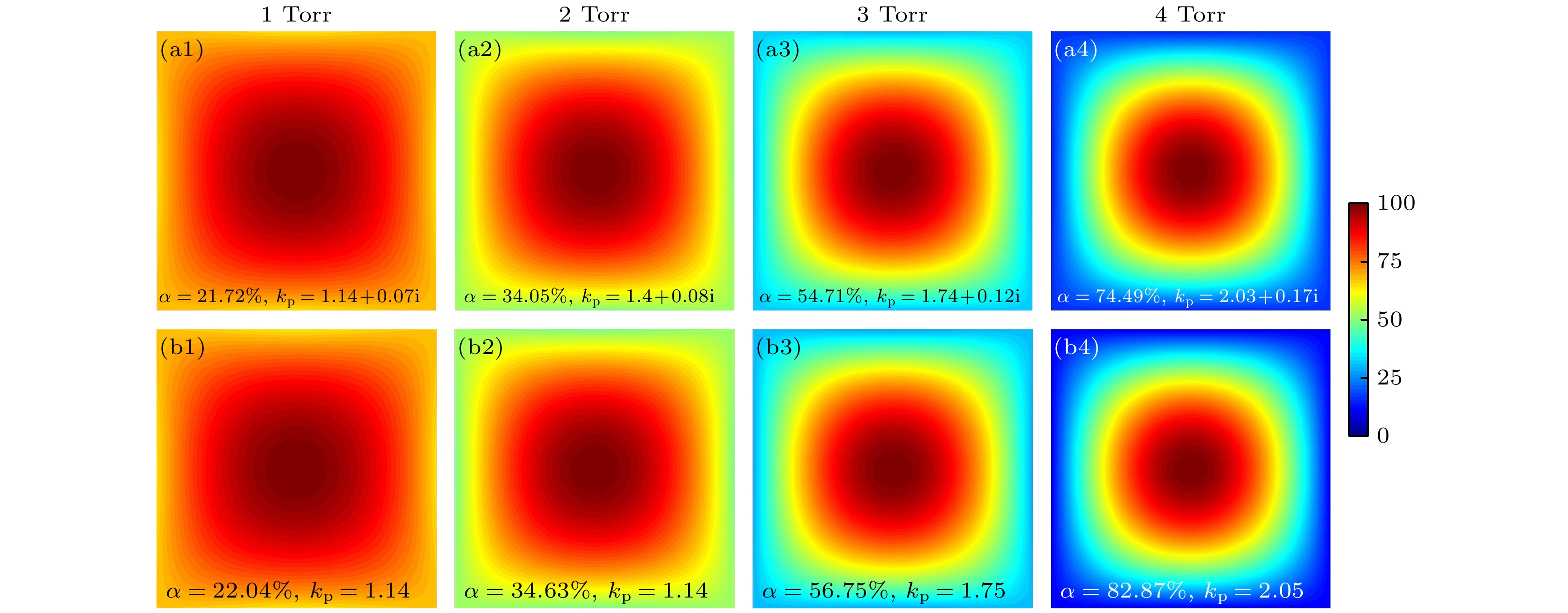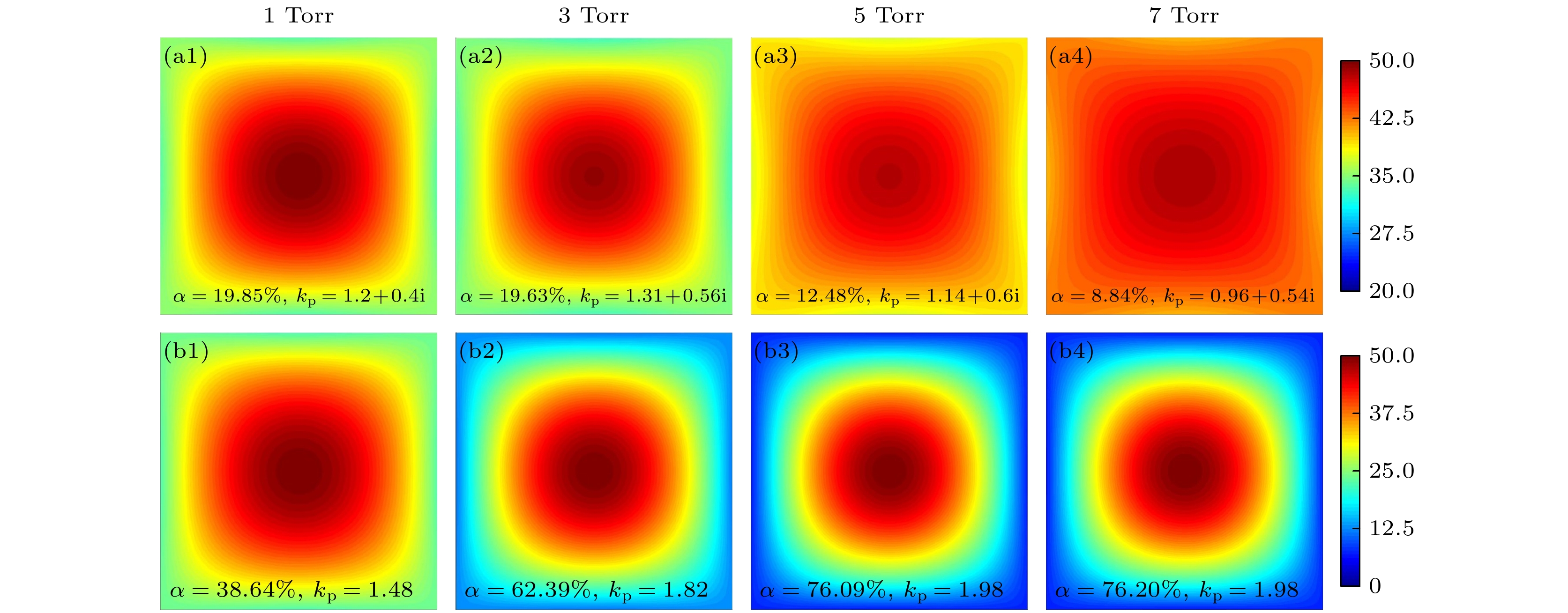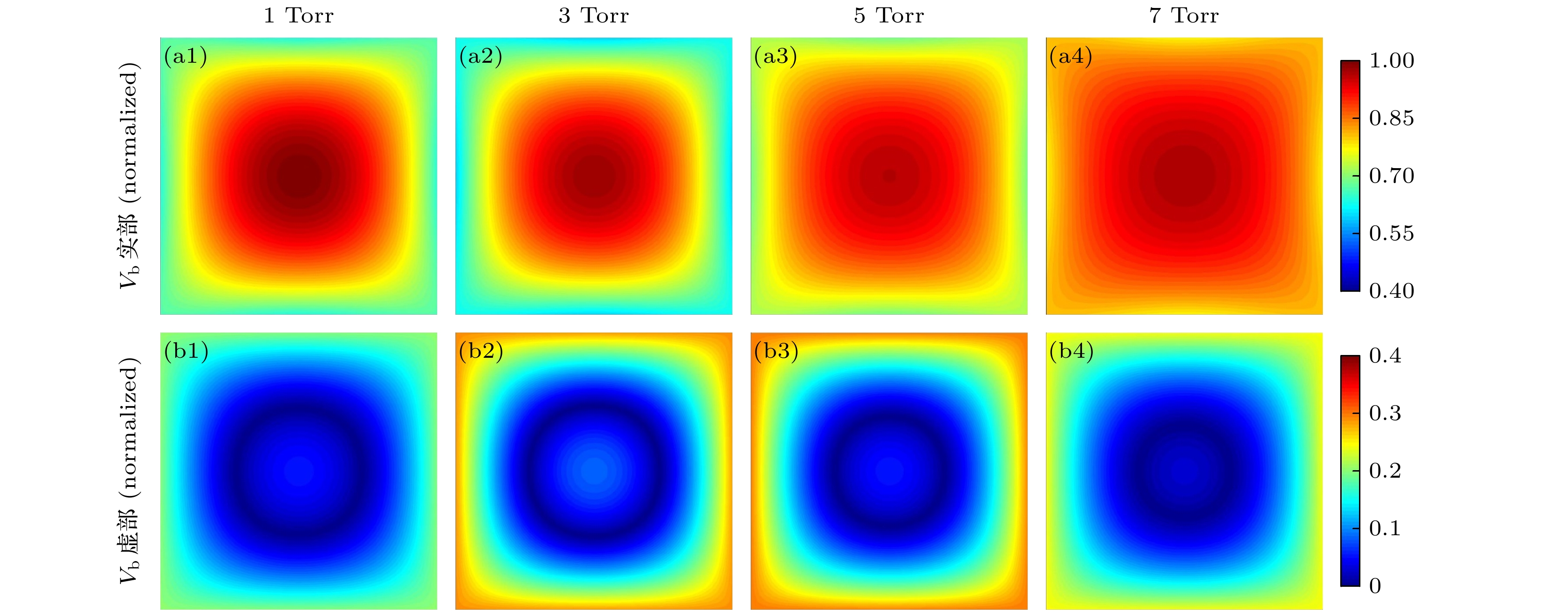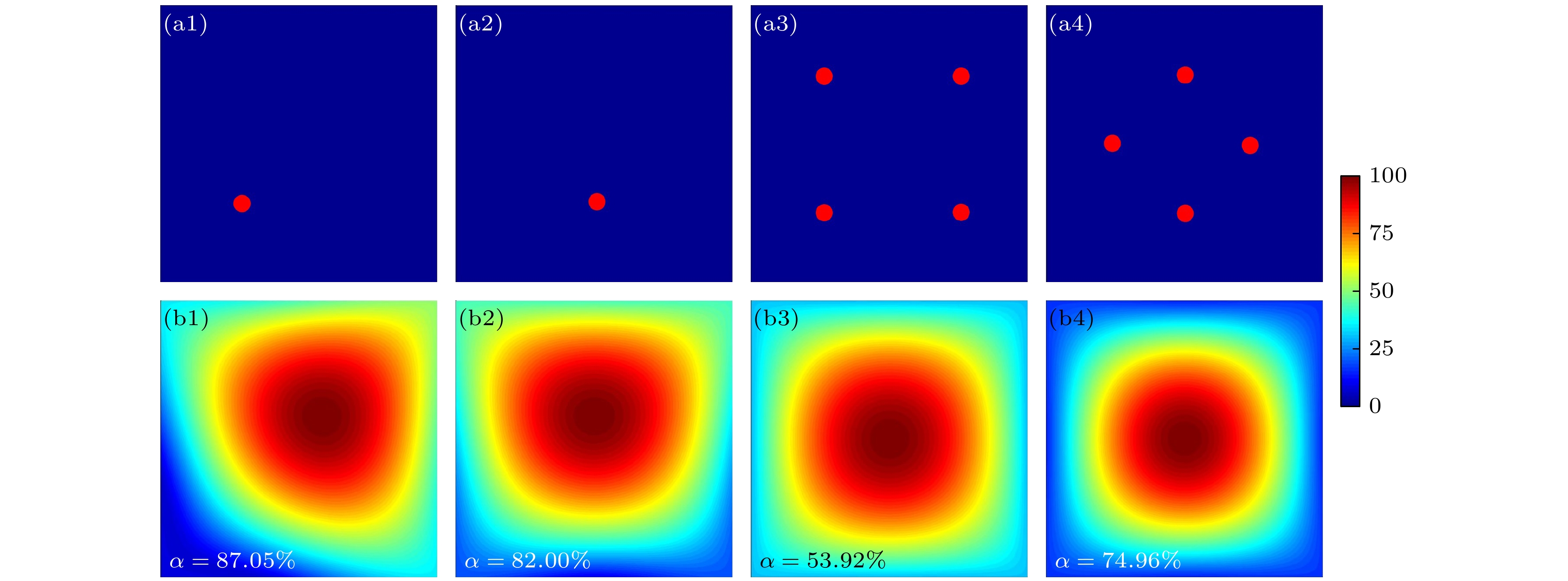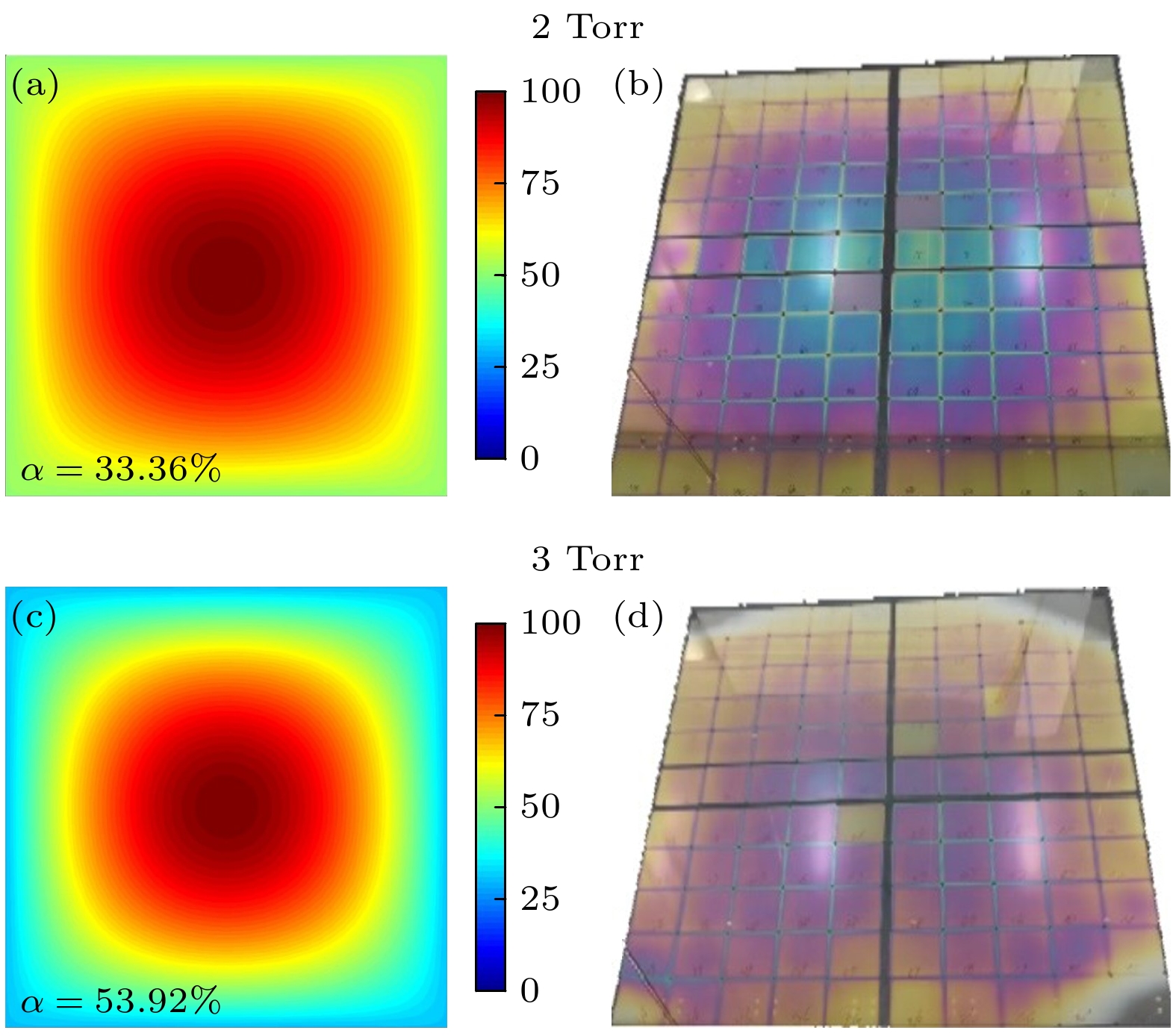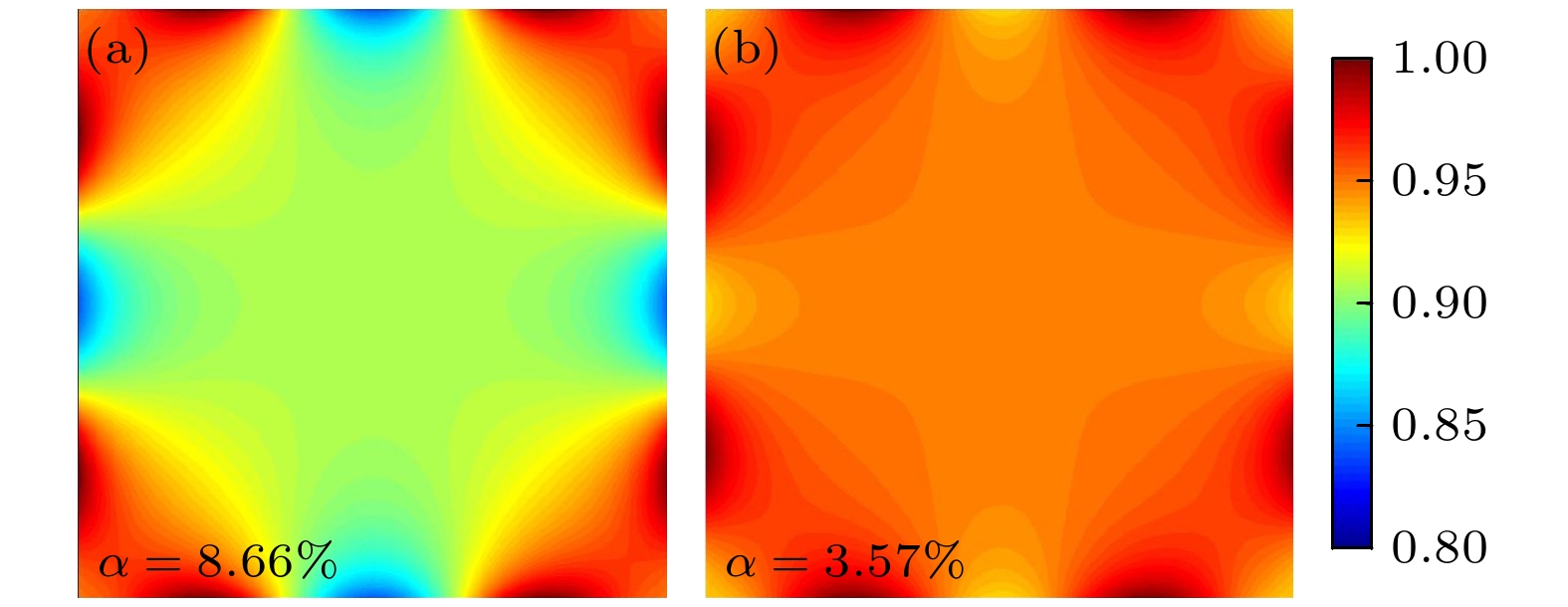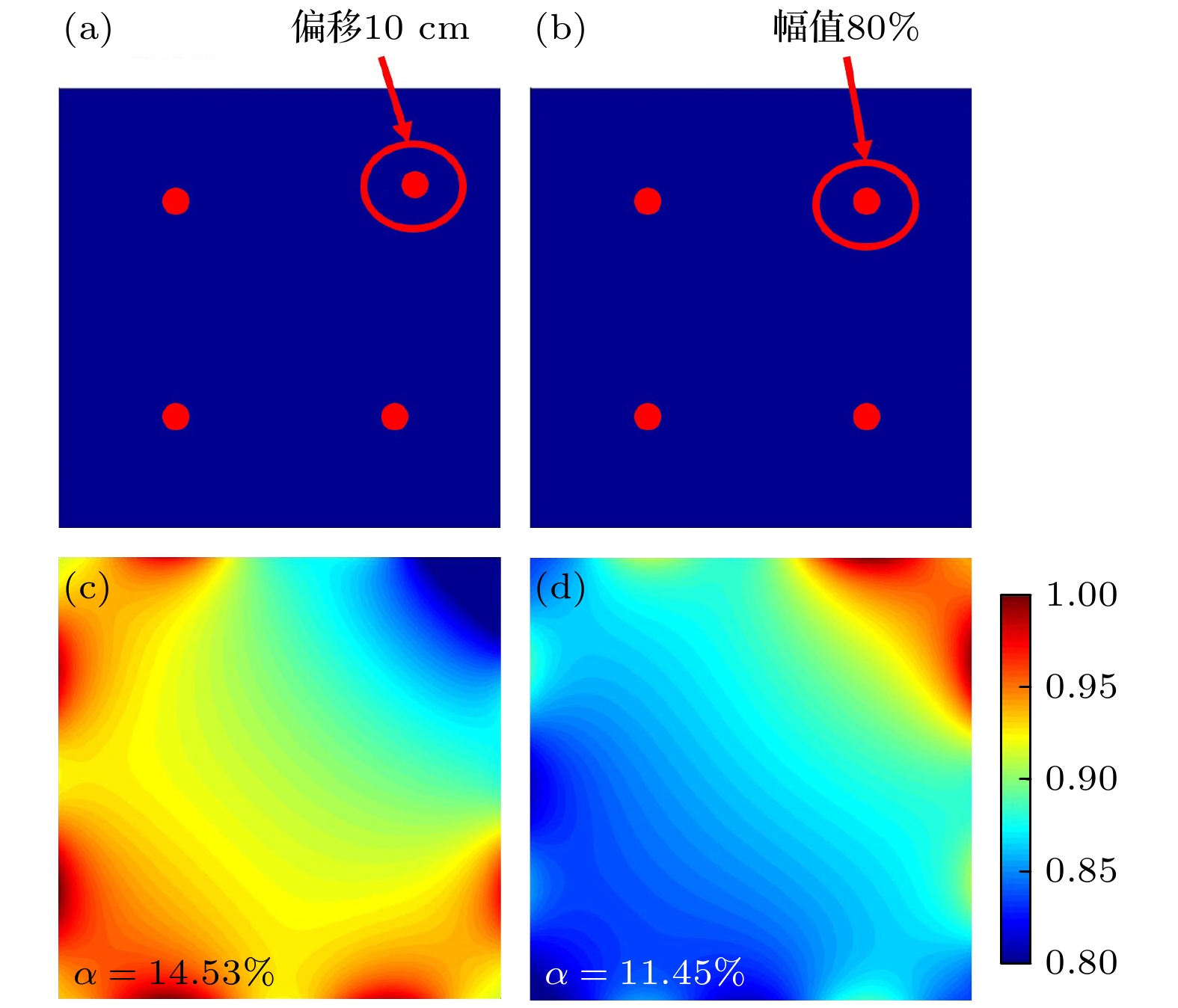-
在光伏和平板显示等领域, 通常采用大面积容性耦合腔室进行等离子体增强化学气相沉积. 随着腔室尺寸增大和驱动频率提高, 受驻波效应影响, 驱动电极电势幅值分布不均匀, 从而导致沉积薄膜不均匀的问题日益凸显. 针对此问题, 本文通过流体模型与传输线模型耦合, 以光伏硅基薄膜沉积中常用的硅烷氢气混合气体为研究对象, 考虑电子-中性粒子弹性碰撞, 研究了气压、气体比例和功率等参数对表面波传播以及驱动电极电势幅值分布的影响. 模拟结果与实际工艺腔室中薄膜沉积实验结果进行了对照, 验证了驱动电极电势幅值分布与薄膜厚度分布之间的对应关系. 研究表明, 在功率较低硅烷含量较高时, 表面波的径向衰减十分显著, 从而成为影响驱动电势幅值分布不均匀的主导因素. 本文还研究了调整电源馈入位置和采用多个电源馈入点来优化电势幅值分布均匀性的方法, 受表面波波长限制, 这两种方法效果有限. 而采用曲面电极能显著提升电势幅值分布的均匀性, 然而对参数设定和加工精度要求较高. 本研究不仅深化了对驻波效应作用机制的理解, 还为工业生产中解决驻波效应对薄膜均匀性的影响提供理论支撑与指导, 有望推动相关产业技术革新.
-
关键词:
- 容性耦合放电 /
- 等离子体增强化学气相沉积 /
- 驻波效应
Large-area capacitively coupled discharges are widely used in plasma enhanced chemical vapor deposition (PECVD) processes for solar cell and display manufacturing. With the increase of the chamber size and driving frequency for improving production efficiency, the non-uniformity of deposited film induced by standing wave effects becomes more serious, which deserves more attention and in-depth research. Based on a fluid model coupled with a transmission line model, the potential amplitude distribution on the powered 2 m2 electrode and the plasma characteristics in a capacitive plasma sustained in a silane/hydrogen discharge driven at 27.12 MHz are investigated. This work identifies three key control parameters: pressure, silane content, and input power, with particular emphasis on radial wave attenuation caused by electron-neutral elastic collisions. The simulation results are validated by industrial experimental results, confirming the relationship between the distributions of potential amplitude on the powered electrode and the film thickness. Two different mechanisms emerge from the analysis. Under the conditions of low silane content and high power, the surface wave radial attenuation is not significant and the surface wave wavelength variations dominate the potential amplitude distribution on the powered electrode. Conversely, in the case of high silane content and low power, significant radial attenuation of the surface wave leads to the noticeable weakening of the standing wave effect due to higher electron-neutral collision frequency. Neglecting the radial attenuation of the surface wave will result in significant deviations in the potential amplitude distribution on the powered electrode as shown in the following figure. Strategies such as adjusting power input positions or using multiple power input are studied to improve uniformity, but the improvements are still limited. Although it requires strict parameter control and machining precision, the shaped electrode demonstrates remarkable uniformity improvement of the potential distribution. In the future work, it is necessary to further analyze the influence of the standing wave effects on the radial distributions of electron, ions, and neutral radicals under complex conditions, such as different chamber structures, gas flows, and temperature distributions, as well as the influence on the quality of deposited films. This will enable a more comprehensive and accurate study of standing wave effects, providing support and guidance for solving real industrial problems. -
Keywords:
- capacitive coupling discharge /
- plasma enhanced chemical vapor deposition /
- standing wave effect
[1] Yu C, Gao K, Peng C W, He C R, Wang S B, Shi W, Allen V, Zhang J T, Wang D Z, Tian G Y, Zhang Y F, Jia W Z, Song Y H, Hu Y Z, Colwell J, Xing C F, Ma Q, Wu H T, Guo L Y, Dong G Q, Jiang H, Wu H H, Wang X Y, Xu D C, Li K, Peng J, Liu W Z, Chen D, Lennon A, Cao X M, De Wolf S, Zhou J, Yang X B, Zhang X H 2023 Nat. Energy 8 1375
 Google Scholar
Google Scholar
[2] Crose M, Kwon J S I, Tran A, Christofides P D 2017 Renewable Energy 100 129
 Google Scholar
Google Scholar
[3] Crose M, Sang Il Kwon J, Nayhouse M, Ni D, Christofides P D 2015 Chem. Eng. Sci. 136 50
 Google Scholar
Google Scholar
[4] Schmidt H 2006 Ph. D Dissertation (Lausanne: EPFL
[5] Schmitt J P M 1989 Thin Solid Films 174 193
 Google Scholar
Google Scholar
[6] Meyyappan M, Colgan M J 1996 J. Vac. Sci. Technol. A 14 2790
 Google Scholar
Google Scholar
[7] Surendra M, Graves D B 1991 Appl. Phys. Lett 59 2091
 Google Scholar
Google Scholar
[8] Curtins H, Wyrsch N, Favre M, Shah A V 1987 Plasma Chem Plasma P 7 267
 Google Scholar
Google Scholar
[9] Liu Y X, Zhang Q Z, Zhao K, Zhang Y R, Gao F, Song Y H, Wang Y N 2022 Chin. Phys. B 31 085202
 Google Scholar
Google Scholar
[10] Kim H J, Lee H J 2017 J. Phys. D: Appl. Phys. 122 053301
 Google Scholar
Google Scholar
[11] Kim H J, Lee H J 2017 Plasma Sources Sci. Technol. 26 085003
 Google Scholar
Google Scholar
[12] Kim H J 2021 Vacuum 187 110104
 Google Scholar
Google Scholar
[13] Kim H J, Lee H J 2016 Plasma Sources Sci. Technol. 25 065006
 Google Scholar
Google Scholar
[14] Schmidt H, Sansonnens L, Howling A A, Hollenstein Ch, Elyaakoubi M, Schmitt J P M 2004 J. Appl. Phys. 95 4559
 Google Scholar
Google Scholar
[15] Sansonnens L, Pletzer A, Magni D, Howling A A, Hollenstein C, Schmitt J P M 1997 Plasma Sources Sci. Technol. 6 170
 Google Scholar
Google Scholar
[16] Lieberman M A, Booth J P, Chabert P, Rax J M, Turner M M 2002 Plasma Sources Sci. Technol. 11 283
 Google Scholar
Google Scholar
[17] Chabert P, Raimbault J L, Rax J M, Lieberman M A 2004 Phys. Plasmas 11 1775
 Google Scholar
Google Scholar
[18] Lee I, Graves D B, Lieberman M A 2008 Plasma Sources Sci. Technol. 17 015018
 Google Scholar
Google Scholar
[19] Lieberman M A, Lichtenberg A J, Kawamura E, Marakhtanov A M 2015 Plasma Sources Sci. Technol. 24 055011
 Google Scholar
Google Scholar
[20] Wen D Q, Kawamura E, Lieberman M A, Lichtenberg A J, Wang Y N 2017 J. Phys. D: Appl. Phys. 50 495201
 Google Scholar
Google Scholar
[21] Zhao K, Liu Y X, Kawamura E, Wen D Q, Lieberman M A, Wang Y N 2018 Plasma Sources Sci. Technol. 27 055017
 Google Scholar
Google Scholar
[22] Lieberman M A, Kawamura E, Chabert P 2022 Plasma Sources Sci. Technol. 31 114007
 Google Scholar
Google Scholar
[23] Liu J K, Zhang Y R, Zhao K, Wen D Q, Wang Y N 2021 Plasma Sci. Technol. 23 035401
 Google Scholar
Google Scholar
[24] Liu Y X, Gao F, Liu J, Wang Y N 2014 J. Appl. Phys. 116 043303
 Google Scholar
Google Scholar
[25] Han D M, Liu Y X, Gao F, Wang X Y, Li A, Xu J, Jing Z G, Wang Y N 2018 J. Appl. Phys. 123 223304
 Google Scholar
Google Scholar
[26] Han D M, Su Z X, Zhao K, Liu Y X, Gao F, Wang Y N 2021 Plasma Sci. Technol. 23 055402
 Google Scholar
Google Scholar
[27] Sansonnens L, Schmidt H, Howling A A, Hollenstein Ch, Ellert Ch, Buechel A 2006 J. Vac. Sci. Technol. A 24 1425
 Google Scholar
Google Scholar
[28] Chen Z, Rauf S, Collins K 2010 J. Appl. Phys. 108 073301
 Google Scholar
Google Scholar
[29] Faraz T, Arts K, Karwal S, Knoops H C M, Kessels W M M 2019 Plasma Sources Sci. Technol. 28 024002
 Google Scholar
Google Scholar
[30] Kuboi N 2023 J. Micro/Nanopattern. Mats. Metro. 22 041502
 Google Scholar
Google Scholar
[31] Oehrlein G S, Brandstadter S M, Bruce R L, et al. 2024 J. Vac. Sci. Technol. B 42 041501
 Google Scholar
Google Scholar
[32] Chang J, Chang J P 2017 J. Phys. D: Appl. Phys. 50 253001
 Google Scholar
Google Scholar
[33] 邱华檀, 王友年, 马腾才 2002 51 1332
 Google Scholar
Google Scholar
Qiu H T, Wang Y N, Ma T C 2002 Acta Phys. Sin. 51 1332
 Google Scholar
Google Scholar
[34] Tinck S, Bogaerts A 2012 Plasma Processes & Polym. 9 522
 Google Scholar
Google Scholar
[35] Kessels W M M, Hoefnagels J P M, Boogaarts M G H, Schram D C, Van De Sanden M C M 2001 J. Appl. Phys. 89 2065
 Google Scholar
Google Scholar
[36] 刘建凯 2022 博士学位论文(大连: 大连理工大学)
Liu J K 2022 Ph. D Dissertation (Dalian: Dalian University of Technology
[37] Sansonnens L 2005 J. Appl. Phys. 97 063304
 Google Scholar
Google Scholar
[38] Jia W Z, Wang X F, Song Y H, Wang Y N 2017 J. Phys. D: Appl. Phys. 50 165206
 Google Scholar
Google Scholar
[39] Jia W Z, Liu R Q, Wang X F, Liu X M, Song Y H, Wang Y N 2018 Phys. Plasmas 25 093501
 Google Scholar
Google Scholar
[40] Bleecker K D, Bogaerts A, Gijbels R, Goedheer W 2004 Phys. Rev. E 69 056409
 Google Scholar
Google Scholar
[41] Brinkmann R P 2007 J. Appl. Phys. 102 093303
 Google Scholar
Google Scholar
-
图 2 不同气压下的考虑(a1)—(a4)和忽略(b1)—(b4)表面波径向衰减情况下的驱动电极电势幅值的二维分布(以下简称电势分布)以及每种情况下的电势分布不均匀度$ \alpha $和表面波波数$ {k}_{{\mathrm{p}}} $, 电极尺寸为2 m × 2 m, 其他放电条件与表2相同
Fig. 2. Two-dimensional distributions of the potential amplitude on the powered electrode with (a1)–(a4) or without (b1)–(b4) the consideration of the surface wave radial attenuation under different pressures, with the potential nonuniformity factor $ \alpha $ and surface wave number $ {k}_{{\mathrm{p}}} $ for each case. Electrode size: 2 m × 2 m; other discharge conditions are the same as in Table 2.
图 3 不同气压下的考虑(a1)—(a4)和忽略(b1)—(b4)表面波径向衰减情况下的电势分布以及每种情况下的电势分布不均匀度$ \alpha $和表面波波数$ {k}_{{\mathrm{p}}} $. 电极尺寸为2 m × 2 m; 其他放电条件与表3相同
Fig. 3. Distributions of the potential with (a1)–(a4) or without (b1)–(b4) the consideration of the surface wave radial attenuation under different pressures, with the potential nonuniformity factor $ \alpha $ and surface wave number $ {k}_{{\mathrm{p}}} $ for each case. Electrode size is 2 m × 2 m; other discharge conditions are the same as in Table 3.
图 4 不同气压下考虑表面波径向衰减时归一化的电势分布的实部(a1)—(a4)和虚部(b1)—(b4). 电极尺寸为2 m × 2 m; 其他放电条件与表3相同
Fig. 4. Distributions of the real part (a1)–(a4) and imaginary part (b1)–(b4) of the normalized potential with the consideration of the surface wave radial attenuation. Electrode size is 2 m × 2 m; other discharge conditions are the same as in Table 3.
图 5 不同案例下电源馈入位置示意图(a1)—(a4)和对应的电势分布(b1)—(b4)以及电势分布不均匀度$ \alpha $. 电极尺寸为2 m × 2 m; 放电气压为3 Torr; 其他放电条件与表2相同
Fig. 5. Distributions of power input positions (a1)–(a4) under different cases, and the potential (b1)–(b4), as well as the potential nonuniformity factor α. Electrode size is 2 m × 2 m; pressure is 3 Torr; other discharge conditions are the same as in Table 2.
图 6 不同气压下采用图5(a1)馈入方式模拟计算的电势分布(a), (c)和相同条件下实验观测的沉积薄膜厚度分布(b), (d). 模拟与实验放电参数相同, 电极尺寸为2 m × 2 m; 其他放电条件与表2相同
Fig. 6. Distributions of the potential from simulation (a), (c) and the deposited film thickness from experiment (b), (d) under different pressures with the case of power input in Fig. 5(a1). Discharge parameters of simulation and experiment are consistent, electrode size is 2 m × 2 m; other discharge conditions are the same as in Table 2.
图 7 不同气压下采用图5(a3)馈入方式模拟计算的电势分布(a), (c)和相同条件下实验观测的沉积薄膜厚度分布(b), (d). 模拟与实验放电参数相同, 电极尺寸为2 m × 2 m; 其他放电条件与表2相同
Fig. 7. Distributions of the potential from simulation (a), (c) and the deposited film thickness from experiment (b), (d) under different pressures with the case of power input in Fig. 5(a1). Discharge parameters of simulation and experiment are consistent, electrode size is 2 m × 2 m; other discharge conditions are the same as in Table 2.
图 8 采用曲面电极和图5(a3)馈入方式情况下放电区域归一化的电势分布. 电极尺寸为2 m × 2 m; 放电气压为 4 Torr; 其他放电条件与表2相同
Fig. 8. Distributions of the normalized potential with the shaped electrode and the case of power input in Fig. 5(a3). Electrode size is 2 m × 2 m; pressure is 4 Torr; other discharge conditions are the same as in Table 2.
图 9 采用曲面电极和图5(a3)馈入方式情况下, 当右上角电源偏离理想位置(a)和电源电流幅值偏离理想值(b)时归一化的电势分布(c), (d). 电极尺寸为2 m × 2 m; 放电气压为 4 Torr; 其他放电条件与表2相同
Fig. 9. Distributions of the normalized potential (c), (d) when the power input position deviates from the ideal position (a) or the current amplitude deviates from the ideal value (b) with the shaped electrode and the case of power input in Fig. 5(a3). Electrode size is 2 m × 2 m; pressure is 4 Torr; other discharge conditions are the same as in Table 2.
表 1 流体模型中计算硅烷氢气放电的反应及其系数
Table 1. Reactions and corresponding coefficients in fluid models for silane/hydrogen discharges.
序号 反应 阈值能/eV 系数[38,39]
/(cm3·s–1)R1 SiH4+e→SiH4+e — cal R2 SiH4+e→$ {{\mathrm{S}}{\mathrm{i}}{\mathrm{H}}}_{3}^{+} $+H+2e 11.9 cal R3 SiH4+e→$ {{\mathrm{S}}{\mathrm{i}}{\mathrm{H}}}_{3}^{-} $+H 5.7 cal R4 SiH4+e→$ {{\mathrm{S}}{\mathrm{i}}{\mathrm{H}}}_{2}^{-} $+2H 5.7 cal R5 SiH4+e→SiH3+H+e 8.3 cal R6 SiH4+e→SiH2+2H+e 8.3 cal R7 H2+e→H2+e — cal R8 H2+e→2H+e 8.9 cal R9 H2+e→$ {{\mathrm{H}}}_{2}^{+} $+2e 15.4 cal R10 Si2H6+e→Si2$ {{\mathrm{H}}}_{4}^{+} $+2H+2e 10.2 cal R11 Si2H6+e→SiH3+SiH2+H+e 7.0 cal R12 $ {{\mathrm{S}}{\mathrm{i}}{\mathrm{H}}}_{3}^{+} $+ $ {{\mathrm{S}}{\mathrm{i}}{\mathrm{H}}}_{3}^{-} $→2SiH3 — 1.0×10–8 R13 $ {{\mathrm{S}}{\mathrm{i}}{\mathrm{H}}}_{3}^{+} $+$ {{\mathrm{S}}{\mathrm{i}}{\mathrm{H}}}_{2}^{-} $→SiH3+SiH2 — 1.0×10–8 R14 $ {{\mathrm{H}}}_{2}^{+} $+$ {{\mathrm{S}}{\mathrm{i}}{\mathrm{H}}}_{3}^{-} $→SiH3+H2 — 1.0×10–8 R15 $ {{\mathrm{H}}}_{2}^{+} $+$ {{\mathrm{S}}{\mathrm{i}}{\mathrm{H}}}_{2}^{-} $→SiH2+H2 — 1.0×10–8 R16 Si2$ {{\mathrm{H}}}_{4}^{+} $+$ {{\mathrm{S}}{\mathrm{i}}{\mathrm{H}}}_{3}^{-} $→SiH3+H2 — 1.0×10–8 R17 Si2$ {{\mathrm{H}}}_{4}^{+} $+$ {{\mathrm{S}}{\mathrm{i}}{\mathrm{H}}}_{2}^{-} $→3SiH2 — 1.0×10–8 R18 SiH4+$ {{\mathrm{H}}}_{2}^{+} $→$ {{\mathrm{S}}{\mathrm{i}}{\mathrm{H}}}_{3}^{+} $+H2+H — 1.0×10–8 R19 SiH4+H→SiH3+H2 — 1.2×10–12 R20 Si2H6+H→H2+Si2H5 — 7.0×10–12 R21 Si2H6+H→SiH3+SiH4 — 3.5×10–12 R22 SiH3+SiH3→SiH4+SiH2 — 1.5×10–10 R23 SiH2+H2→SiH4 — 2.7×10–14 R24 SiH2+SiH4→Si2H6 — 2.3×10–11 表 2 不同气压下周期和空间平均的电子密度($ {n}_{{\mathrm{e}}} $)、鞘层厚度($ {d}_{{\mathrm{s}}{\mathrm{h}}} $)、趋肤深度($ \delta $)、电子-中性粒子弹性碰撞频率($ {\upsilon }_{{\mathrm{e}}{\mathrm{n}}} $)和电极间有效相对介电常数($ {\varepsilon }_{{\mathrm{e}}{\mathrm{f}}{\mathrm{f}}} $); 放电条件为电压幅值100 V, 间距1.6 cm, 功率范围8—12 kW, SiH4/SiH4+H2 = 1%
Table 2. Periodically and spatially averaged electron density ($ {n}_{{\mathrm{e}}} $), sheath thickness ($ {d}_{{\mathrm{s}}{\mathrm{h}}} $), skin depth ($ \delta $), electron-neutral elastic collision frequency ($ {\upsilon }_{{\mathrm{e}}{\mathrm{n}}} $), and effective relative permittivity ($ {\varepsilon }_{{\mathrm{e}}{\mathrm{f}}{\mathrm{f}}} $) under different pressures; discharge conditions: voltage 100 V, gap 1.6 cm, power range 8–12 kW, SiH4/SiH4+H2 = 1%.
p/Torr $ {n}_{{\mathrm{e}}} $/(1015 m–3) $ {d}_{{\mathrm{s}}{\mathrm{h}}} $/cm $ \boldsymbol{\delta } $/cm $ {\upsilon }_{{\mathrm{e}}{\mathrm{n}}} $/(1010Hz) $ {\varepsilon }_{{\mathrm{e}}{\mathrm{f}}{\mathrm{f}}} $ 1 5.98 0.20 6.88 0.36 4.02+0.46i 2 19.56 0.13 3.80 0.72 6.08+0.68i 3 37.57 0.08 2.74 1.08 9.30+1.29i 4 55.81 0.06 2.25 1.44 12.65+2.20i 表 3 不同气压下周期和空间平均的电子密度($ {n}_{{\mathrm{e}}} $)、鞘层厚度($ {d}_{{\mathrm{s}}{\mathrm{h}}} $)、趋肤深度($ \delta $)、电子-中性粒子弹性碰撞频率($ {\upsilon }_{{\mathrm{e}}{\mathrm{n}}} $)和电极间相对介电常数($ {\varepsilon }_{{\mathrm{e}}{\mathrm{f}}{\mathrm{f}}} $), 放电条件为电压幅值50 V, 间距2 cm, 功率大致2—5 kW, SiH4/SiH4+H2 = 90%
Table 3. Periodically and spatially electron density ($ {n}_{{\mathrm{e}}} $), sheath thickness ($ {d}_{{\mathrm{s}}{\mathrm{h}}} $), skin depth ($ \delta $), electron-neutral elastic collision frequency ($ {\upsilon }_{{\mathrm{e}}{\mathrm{n}}} $), and effective relative permittivity ($ {\varepsilon }_{{\mathrm{e}}{\mathrm{f}}{\mathrm{f}}} $) under different pressures, discharge conditions: voltage 50 V, gap 2 cm, power range 2–5 kW, SiH4/SiH4+H2 = 90%.
p/Torr $ {n}_{{\mathrm{e}}} $/(1015 m–3) $ {d}_{{\mathrm{s}}{\mathrm{h}}} $/cm ${\delta } $/cm $ {\upsilon }_{{\mathrm{e}}{\mathrm{n}}} $/(1010 Hz) $ {\varepsilon }_{{\mathrm{e}}{\mathrm{f}}{\mathrm{f}}} $ 1 2.40 0.15 10.86 0.59 3.99+3.02i 3 7.72 0.10 6.06 1.77 4.33+4.53i 5 9.12 0.08 5.57 2.94 2.88+4.25i 7 8.70 0.08 5.70 4.12 1.94+3.18i -
[1] Yu C, Gao K, Peng C W, He C R, Wang S B, Shi W, Allen V, Zhang J T, Wang D Z, Tian G Y, Zhang Y F, Jia W Z, Song Y H, Hu Y Z, Colwell J, Xing C F, Ma Q, Wu H T, Guo L Y, Dong G Q, Jiang H, Wu H H, Wang X Y, Xu D C, Li K, Peng J, Liu W Z, Chen D, Lennon A, Cao X M, De Wolf S, Zhou J, Yang X B, Zhang X H 2023 Nat. Energy 8 1375
 Google Scholar
Google Scholar
[2] Crose M, Kwon J S I, Tran A, Christofides P D 2017 Renewable Energy 100 129
 Google Scholar
Google Scholar
[3] Crose M, Sang Il Kwon J, Nayhouse M, Ni D, Christofides P D 2015 Chem. Eng. Sci. 136 50
 Google Scholar
Google Scholar
[4] Schmidt H 2006 Ph. D Dissertation (Lausanne: EPFL
[5] Schmitt J P M 1989 Thin Solid Films 174 193
 Google Scholar
Google Scholar
[6] Meyyappan M, Colgan M J 1996 J. Vac. Sci. Technol. A 14 2790
 Google Scholar
Google Scholar
[7] Surendra M, Graves D B 1991 Appl. Phys. Lett 59 2091
 Google Scholar
Google Scholar
[8] Curtins H, Wyrsch N, Favre M, Shah A V 1987 Plasma Chem Plasma P 7 267
 Google Scholar
Google Scholar
[9] Liu Y X, Zhang Q Z, Zhao K, Zhang Y R, Gao F, Song Y H, Wang Y N 2022 Chin. Phys. B 31 085202
 Google Scholar
Google Scholar
[10] Kim H J, Lee H J 2017 J. Phys. D: Appl. Phys. 122 053301
 Google Scholar
Google Scholar
[11] Kim H J, Lee H J 2017 Plasma Sources Sci. Technol. 26 085003
 Google Scholar
Google Scholar
[12] Kim H J 2021 Vacuum 187 110104
 Google Scholar
Google Scholar
[13] Kim H J, Lee H J 2016 Plasma Sources Sci. Technol. 25 065006
 Google Scholar
Google Scholar
[14] Schmidt H, Sansonnens L, Howling A A, Hollenstein Ch, Elyaakoubi M, Schmitt J P M 2004 J. Appl. Phys. 95 4559
 Google Scholar
Google Scholar
[15] Sansonnens L, Pletzer A, Magni D, Howling A A, Hollenstein C, Schmitt J P M 1997 Plasma Sources Sci. Technol. 6 170
 Google Scholar
Google Scholar
[16] Lieberman M A, Booth J P, Chabert P, Rax J M, Turner M M 2002 Plasma Sources Sci. Technol. 11 283
 Google Scholar
Google Scholar
[17] Chabert P, Raimbault J L, Rax J M, Lieberman M A 2004 Phys. Plasmas 11 1775
 Google Scholar
Google Scholar
[18] Lee I, Graves D B, Lieberman M A 2008 Plasma Sources Sci. Technol. 17 015018
 Google Scholar
Google Scholar
[19] Lieberman M A, Lichtenberg A J, Kawamura E, Marakhtanov A M 2015 Plasma Sources Sci. Technol. 24 055011
 Google Scholar
Google Scholar
[20] Wen D Q, Kawamura E, Lieberman M A, Lichtenberg A J, Wang Y N 2017 J. Phys. D: Appl. Phys. 50 495201
 Google Scholar
Google Scholar
[21] Zhao K, Liu Y X, Kawamura E, Wen D Q, Lieberman M A, Wang Y N 2018 Plasma Sources Sci. Technol. 27 055017
 Google Scholar
Google Scholar
[22] Lieberman M A, Kawamura E, Chabert P 2022 Plasma Sources Sci. Technol. 31 114007
 Google Scholar
Google Scholar
[23] Liu J K, Zhang Y R, Zhao K, Wen D Q, Wang Y N 2021 Plasma Sci. Technol. 23 035401
 Google Scholar
Google Scholar
[24] Liu Y X, Gao F, Liu J, Wang Y N 2014 J. Appl. Phys. 116 043303
 Google Scholar
Google Scholar
[25] Han D M, Liu Y X, Gao F, Wang X Y, Li A, Xu J, Jing Z G, Wang Y N 2018 J. Appl. Phys. 123 223304
 Google Scholar
Google Scholar
[26] Han D M, Su Z X, Zhao K, Liu Y X, Gao F, Wang Y N 2021 Plasma Sci. Technol. 23 055402
 Google Scholar
Google Scholar
[27] Sansonnens L, Schmidt H, Howling A A, Hollenstein Ch, Ellert Ch, Buechel A 2006 J. Vac. Sci. Technol. A 24 1425
 Google Scholar
Google Scholar
[28] Chen Z, Rauf S, Collins K 2010 J. Appl. Phys. 108 073301
 Google Scholar
Google Scholar
[29] Faraz T, Arts K, Karwal S, Knoops H C M, Kessels W M M 2019 Plasma Sources Sci. Technol. 28 024002
 Google Scholar
Google Scholar
[30] Kuboi N 2023 J. Micro/Nanopattern. Mats. Metro. 22 041502
 Google Scholar
Google Scholar
[31] Oehrlein G S, Brandstadter S M, Bruce R L, et al. 2024 J. Vac. Sci. Technol. B 42 041501
 Google Scholar
Google Scholar
[32] Chang J, Chang J P 2017 J. Phys. D: Appl. Phys. 50 253001
 Google Scholar
Google Scholar
[33] 邱华檀, 王友年, 马腾才 2002 51 1332
 Google Scholar
Google Scholar
Qiu H T, Wang Y N, Ma T C 2002 Acta Phys. Sin. 51 1332
 Google Scholar
Google Scholar
[34] Tinck S, Bogaerts A 2012 Plasma Processes & Polym. 9 522
 Google Scholar
Google Scholar
[35] Kessels W M M, Hoefnagels J P M, Boogaarts M G H, Schram D C, Van De Sanden M C M 2001 J. Appl. Phys. 89 2065
 Google Scholar
Google Scholar
[36] 刘建凯 2022 博士学位论文(大连: 大连理工大学)
Liu J K 2022 Ph. D Dissertation (Dalian: Dalian University of Technology
[37] Sansonnens L 2005 J. Appl. Phys. 97 063304
 Google Scholar
Google Scholar
[38] Jia W Z, Wang X F, Song Y H, Wang Y N 2017 J. Phys. D: Appl. Phys. 50 165206
 Google Scholar
Google Scholar
[39] Jia W Z, Liu R Q, Wang X F, Liu X M, Song Y H, Wang Y N 2018 Phys. Plasmas 25 093501
 Google Scholar
Google Scholar
[40] Bleecker K D, Bogaerts A, Gijbels R, Goedheer W 2004 Phys. Rev. E 69 056409
 Google Scholar
Google Scholar
[41] Brinkmann R P 2007 J. Appl. Phys. 102 093303
 Google Scholar
Google Scholar
计量
- 文章访问数: 294
- PDF下载量: 13
- 被引次数: 0













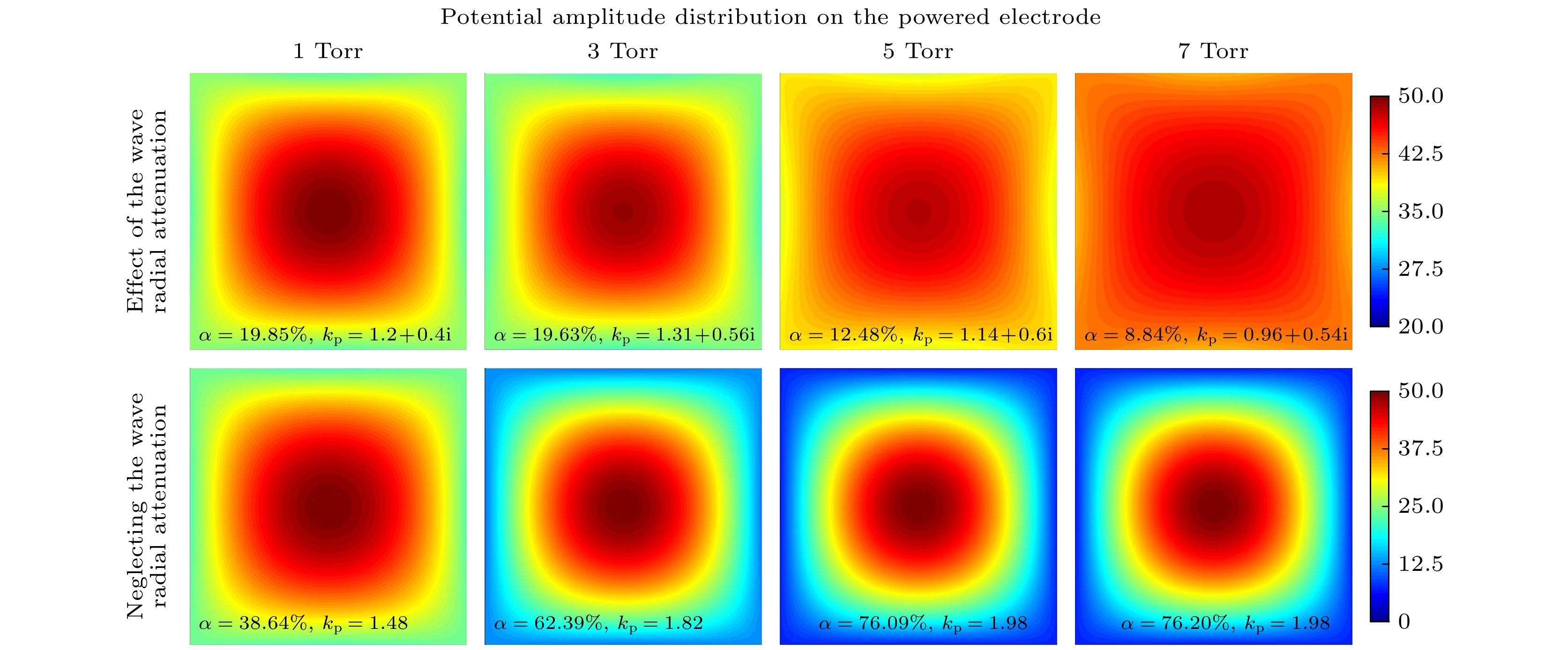

 下载:
下载:
